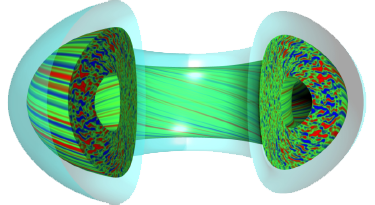Speaker
Description
“Fusion Cloud” is a new concept to realize an interdisciplinary data analysis platform primarily based on fusion experiments and numerical modeling data across academic institutions and universities in Japan. Not only for the next-generation fusion experiment’s diagnostics and operations, such as in ITER and JT-60SA, but also for enabling the fusion demo reactor designs, some standard platform will be highly expected on which the integrated data processing, validation, analysis and model calculations would be performed. The Integrated Modeling and Analysis Suite (IMAS) is a well-known activity to develop a cluster of necessary software toward the ITER era.
The Fusion Virtual Laboratory (FVL) was the Japanese inter-university remote collaboration platform over several fusion experiments, whose data linkage has been established through the dedicated virtual private network named SNET. To date, the LHD-SNET unified data storage has been storing approximately 3 peta-bytes (PB) of fusion experimental data collected from LHD and other university experiments remotely via SNET. The distributed data acquisition, archiving, and analysis systems constitute an integrated data system infrastructure that transparently links multiple fusion experiments via high-speed long-distance academic network SINET. The latest technologies for fusion experiments, the LABCOM high-bandwidth real-time streaming data acquisition and the AutoAna/EG data processing and analysis automation by data synchronization triggers, have been newly developed and the effectiveness has been practically demonstrated in LHD-SNET.
Both in terms of research data management (RDM) and open science (OS), digital data properties generated by LHD and SNET experiments are considered to be open by means of assigning global persistent identifiers, such as DOI (Digital Object Identifier), to enable universal access by the public and enhance the opportunities for reuse and re-evaluation. It will also help researchers to directly refer and cite the data object they used in publication and presentation. With considering the FAIR (Findable, Accessible, Interoperable and Reusable) data principles, more specific platform designs are developed underway.
The Fusion Science Information Centre is also a new project of QST (ITER Japan Domestic Agency), which aims to unify the Fusion Science Data Centre (DC), the Computation Simulation Centre (CSC) and the Remote Experimentation Centre (REC) to realize a hybrid platform for fusion data analysis and computation. The NIFS institutional repository is already operated on the JAIRO Cloud open-access repository platform, a part of the Gakunin RDM of National Institute for Informatics (NII). “Fusion Cloud” will challenge the integration of the relevant platforms and also the established system technologies developed in LHD and SNET toward the next-generation fusion research activities.
| Country or International Organisation | Japan |
|---|---|
| Affiliation | National Institute for Fusion Science |

